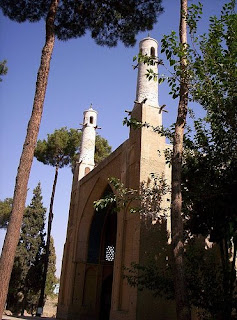
Jan 24, 2011
Jun 2, 2009
About Iran

Communication
Telephone: IDD service available. Country code: 98. Outgoing international code: 00.
Telex/telegram: Facilities are available at the Central Telegraph Office, Meydan Sepah, Tehran. There are also telex facilities at the major hotels.
Post: Post Offices are found throughout all cities, towns and villages.
According to the Islamic and social beliefs in Iran, it is necessary for women to be modestly covered & wearing ahead scarf.
The import of following goods into Iran is strictly prohibited: Alcohol, narcotics, guns and ammunitions, radio apparatus, fashion magazines and obscene publications, and filmed, recorded or printed material carrying views contrary to those held by the Islamic regulations. Each passenger leaving the country is permitted to take his/her own personal luggage as well as Persian handicrafts, kilims and one carpet (not bigger than 3 sqm) as long as they are not antiques. Export of all antiques such as gems, coins, handwritten manuscripts is prohibited.
To export musical instruments, a permit is required from the Ministry of Culture and Islamic Guidance.
Legislative power is vested in the Islamic Consultative Assembly (Majlis), with 275 members. The chief executive is the President, and both are elected by universal adult suffrage for a four-year term.
A twelve-member Council of Guardians ensures that legislation is in accordance with the constitution and Islamic precepts.
Persian (Farsi) is the most widely spoken language. Arabic is spoken in Khuzestan in the southwest, and Turkish in the northwest around Tabriz. English, French and (to a lesser extent) German are spoken by many businessmen and officials.
Middle East.
Area: 1,648,000 sq km (636,296 sq miles).
Population: 68,727,000 (1998 estimate).
Population Density: 35 per sq. km.
Capital: Tehran. Population : 8,042,584(1994)
Geography: Iran is located in the Middle East, bounded to the north by the CIS and the Caspian Sea, the east by Afghanistan and Pakistan, the south by the Persian Gulf and the Gulf of Oman, and the west by Iraq and Turkey.
The center and east of the country is largely barren undulating desert, punctured by Qantas (irrigation canals and tree eases, but there are mountainous regions in the west along the Turkish and Iraqi borders and in the north where the Alborz Mountains rise steeply from a fertile belt around the Caspian Sea.
Currency: Iranian Rials. Notes are in denominations of RL 10000, 5000, 2000, 1000, 500, 200 and 100. Coins are in denominations of 250, 100, 50, 20, 10 and 5.All foreign currencies such as Euros, Pound Sterling, US Dollars and Yens can be exchanged and credit cards (Mastercard & Visa) are also accepted.
Masouleh

 A kind of life pattern occurs wherever natural and humanity variety is intermingled, under realm of time and history, which can be exceptional and unique for its part.
A kind of life pattern occurs wherever natural and humanity variety is intermingled, under realm of time and history, which can be exceptional and unique for its part.MASOULEH as a national relic is an obvious type of the historic habituate of mankind, which has been registered as No.1090 in national relics list of country in solar1354. This historic town, during its 1000 age, is an obvious type in fantastic harmony between nature and human. It is located at 37, 09,13N latitude and at 48,59,14E longitude and farthest end of damp Caspian climate region. It is situated valley of river, whose sources are near the second high peak of TALESH mauntain (MASOULEH-DAGH with 3050m height). Its height is 1050 m from open sea and difference between its the highest the lowest points are more than 120m.
The combination of TALESH, TURKEY and GILAKY triple cultures from one side and the the forest, the pasture and mountainous triple natures from other side, creat a culture and civilization, that the first fade of it, is the specific architecture and urban development if Masouleh. So that, these triple cultures and natures and specific architecture have an effect on each other. By this order, in a continuous and constant cooperation, it has created wonderful dynamism in historic lifetime of Masouleh
This old town with 1.6 hectare extent is based on four neighborhoods: KHANEH-BAR, KASHEH-SAR, ASAD-MAHALLEH and MASJED-BAR. Also Masouleh has four floors that each neighborhoods connect to it directly. In Masouleh, at the moment, there are more than 350 residential units, which have been 600 units in past (about 100 years ago). Being of more than 120 commercial units around its bazaar, more than 6 caravanserai, 2 traditional baths, more than 33 public springs, 10 mosques and 5 shrines strike a note of improvement and splendour of this town in recent years. During 60 past years, Masouleh population has decreased from 3500 to 900. This shows descending history progress of this ancient town.
Humans, created this habitat, urban farm and fantastic architecture in a quite agreeable life with nature, if they knew their off springs behaved with their products in this way, they would not doubtly transfer this condition to them.
In recent decodes for different reasons historic-cultural and environmental identity of this rare collection has been altered and present situation of the valuable town is not suitable for fame before. Nevertheless, Masouleh is proverbial among all five wonderful town-village (ABYANEH, KANDOVAN, MEYMAND and SAR-SEIEDAGHA). Maybe thousands of travelers (passengers) visit this historic town and natural landscapes yearly. In summer more passengers visit Masouleh, because of its temperature and damp weather. Although its attraction in three other seasons is more than summer.
All passengers interest in natural sights not only can see strange views of natures in spring, fall and winter, but also is suitable for whom want silent and calm place.
May 27, 2009
Abyaneh

 Being a village of great antiquity, Abyaneh is like a living architectural and anthropological museum. It affords an impressive exponent of the adaptation of man with his environment. Being a village of great antiquity, Abyaneh is like a living architectural and anthropological museum. It affords an impressive exponent of the adaptation of man with his environment.It is located on the north-western slope of Mt Karkas, 2 kms away from Natanz (a town in Isfahan province). It is 2500 meters above sea level. At a place called Hanjan is 55 kms away from Kashan and 25 kms away from Abyaneh. Abyaneh is mainly watered by the river of Barzrud. Set on the slope of the lofty mountain of Karkas, this village has a cold climate and enjoys numerous springs creating a favorite condition for agriculture. Considering the evidence found in Abyaneh, it dates back to antiquity, but its golden age was during the Safavid period. The word Abyaneh has been derived from the word "viona" meaning willow grove. (In the local dialect "vey" means willow.)  The village is expanded along the river, and its configuration indicates that in the past the people showed much consideration for security. Although the village itself is situated on high ground, there are three castles that protected the people when the enemy attacked. furthermore, the configuration of Abyaneh protects it from strong winds and floods. Abyaneh has a compact fabrication with narrow and steep alleys. Set on the slope of the mountain, the houses are arranged in a stair-step shape, so that the mountain, the houses are the yards of the others. The materials used for building the roofs are timbers, straw and clay. The materials use for building the roofs are timbers, straw and clay. The walls, built by red mud bricks are impressive. The mud bricks are of quality that become harder when they are exposed to the rain. To use the sun as much as possible, the houses face the east. An impressive aspect of Abyaneh's architectures is that the houses are uniform in appearance. The doors, most of which have two knockers, are wooden and built in traditional styles. There are beautiful patterns, poems and the names of the owner and mason carved on some doors. These poems afford a good picture of the old Iranian culture. Many facades date back to the Safavid period. Beside the door of many houses there are small platforms providing place for passers-by or local residents to rest for a while. The simplicity found in Abyaneh's houses affords a picture of life in rural Iran. Each room is used for various purposes. For example, a single room may be used as a dining-room, a sitting-room, a bed-room and a guest-room. To economize in the use of fuel, the rooms and used in winter are architecturally different from those used in summer. For providing equal light for all parts of the rooms, there are several small openings in the roofs. The size of the rooms, windows and doors all indicate the simplicity of life in this old village. Abyaneh is called an entrance to the Iranian history. In some of the houses there is earthenware belonging to a few hundred years ago. The local traditional clothes are in style of great antiquity. It is said a woman of Abyaneh has inherited her wedding dress from her grandmother. The language (an Iranian language of the Parthian people who were inhabitants of an ancient country to the southeast of the Caspian Sea, now a part of NE Iran). In addition to natural beauties, there are several historical monuments in Abyaneh, of which the following are of more significance. |
May 16, 2009
Narenjestan-e-Qavam


Narenjestan building, known as “Narenjestan Qavam” is a part of Qavam complex. It was designed and used as “Birouni” (a part of building to receive people out of the family circle). It was the domicile of Governor’s Court of Fars during Qajar period.
It also includes Zinat-ol-molk house, designed and used as “Andarouni” (part of the home for only the close family).
The other parts of the complex were: Private bath house, public bath house, Husseinieh (religious ceremonies building, detention house and stable. The detention house and stable no longer exist. Narenjestan and Zinat-ol-molk buildings (Andarouni and Birouni) were connected via underground passage way.
The complex is a significant representation of Iranian architecture during "Qajar" period. Narenjestan and Zinat-ol-molk buildings are examples of traditional Iranian residential architecture.
This structure was built between 1879-1886 on the Northern side of the luxuriant "Narenjestan Garden" in Shiraz. Its construction is attributed to "Mirza Ebrahim Khan", the great grandson of the elder "Qavam" and grandfather of the contemporary "Qavamolmolk", with the assistant of a master mason.
In 1965, Narenjestan was handed over to the staffs of Asian Institute and Shiraz University. One of its halls was being transformed into a museum later.
It is necessary to mention, that Professor Arthur Upham Pope spent 50 years of his time life, working here, dedicating it numerous antique artifacts. Museum's collections of photographs and slides, initiated by Professor Pope, are also preserved here.
May 15, 2009
Kataleh Khor Cave


Kataleh Khor Cave, one of the most beautiful in the world, is located 165 km southwest of Zanjan. The entrance to the cave is situated on the southern slopes of the 2,000-meter high Saghizloo Mountain.
The cave has flat walls with high ceiling and archeologists estimate the age of the cave at 30 million years. The entrance to Kataleh Khor resembles a crevice at the beginning and culminates in a triangular arch. Archeologists have made the entrance bigger and it currently stands at 1.5 meter high.
The first labyrinth is 400 meters from the entrance of the cave. It is expansive and has a high ceiling.
After the labyrinth, the gallery, channels and passages have taken shape gradually becoming larger or smaller. The area of the labyrinth is 200-300 square meters. Chains of galleries are separated from each other. Some of them are open ended while others have narrow strip linking to other passages or labyrinths.
Some of the strips have yet not been paved while others remain undiscovered। The floor of the labyrinths and channels are uneven and have formed through the ages with the dissolution of stones and shaping of new waterways.
Sometimes the waterways are deep and wide in the labyrinths and passages and there are crystallized stalactites which are beautiful and have taken shape from top to the bottom. They are spectacular.
Those who have been through the cave say that the visibility inside the cave extends to 700 meters. Some potteries dating back to 2000 BC have been found in the cave.
The second type of potteries obtained from the cave is reddish to brown in color. They can be compared with those belonging to the third century AD. The third type of potteries obtained from the cave is modern and are of no historical value. At the end of one of channels of the first floor, there is a skeleton of four-legged animal which has turned into "Calcite" in the form of monster.
In 1951, a veteran mountaineer from Zanjan, Asadollah Jamali discovered the mysterious cave and a team visited it the following year.
Since 1993, structure have been constructed in the vicinity of the cave to host visitors. Special lights and projectors have been installed to help visitors to get a glimpse of the unknown world inside the cave.
May 14, 2009
Alvand Summit, Hamadan


The mountainous region of Alvand embrace the important summits of the province। The Quri chay and Qarah Chay Rivers take their sources in the northern slopes, and the Yujari Chay and Khoram Abad Rivers take their sources in the south western skirts। The most suitable route to the Alvand peak is from the Ganj Nameh route (Hamadan) in Abbas Abad. In the skirts of Alvand Mountains, 'Kallaq Lan', 'Chal Qibleh' and 'Chal Nabaleqan' are equipped with facilities to accommodate visitors.
Alisadr Cave, Kabudrahang

The said cave is the largest in the world, containing water and offering the use of canoes. This cave is located in the village of Alisadr, district of Kabudrahang, and was inaugurated in the year 1967. In the hills where the Alisadr cave is located, there are two other caves by the names of Soo Bashi and Sarab Caves.
The water present in Alisadr Cave, takes its source from that of the Sarab Cave. The Alisadr Cave comprises of a number of small and large 'halls' or spaces, in a maze like fashion, connected to each other by passages.
The water within the cave is extremely cold but very clear, odorless, colorless and with an ordinary taste. It comes under the calcium bicarbonate category, is nearly neutral in PH, but unfortunately polluted. The ceiling of the cave is covered with a sedimentation of pure calcium carbonate and a mixture of other chemical compounds. Thus forming stalagmites of unique beauty and design, which draws the attention of visitors. The air within the cave is light and static.
To date, all the canals of this cave have not been discovered, and only approximately 2,100 m. have been recognized. Here, the height of the ceiling is between 1-35 m. the width of the canals 2 - 15 m. and the depth of the water 1 - 17 m. Within the cave, electric power, and paddling canoes (seating 4 persons) aid visitors to see parts of this cave.
Park-e Melli-e Kavir

Kavir National Park is located in the west of Semnan desert. Its 60km far from Tehran. Tehran-Garmsar road, Esfahan Province and Qom Great Salt Lake are on its north, south and west.
There are three ways to get to the Park:
A: Getting to Garmsar from Tehran and to Ghasr-e Bahram from there. And then 30km in a dirt road which becomes swampy in the raining season.
B: The second way which is more common is the Tehran-Pishva-Mobarakeh way. Go to Varamin from Tehran and the rest wont be hard to find.
C: You can visit Maranjab and then with a 3 hour drive to north in a sand road you can get to the Park. But remember this way should be passed by a 4WD.
May 13, 2009
Manar Jonban

At the beginning of the 17th century in 1606 during Safavid period, work on the cathedral began. However, in 1655, this Armenian church was rebuilt as the Christian community was rapidly growing in Isfahan.
A tilework plaque inscribed in Armenian can be seen by the entrance to the cathedral. Inside is nicely decorated showing a mixture of Islamic and Christian style. Inside the courtyard, there is the belfry and can see the dome of the cathedral which the interior is painted in Persian style with very elegant blue and gold. The walls are painted of European inspirations showing scenes of martyrdom, notably of Saint Gregory.
The museum of Armenian culture is the building next to the cathedral. The museum displays 700 handwritten books, the first book printed in Iran, a variety of objects related to Armenian community in Isfahan such as Safavid costumes, tapestries, European paintings brought back by Armenian merchants , embroidery, and other ethnological displays related to Armenian culture and religion. There are several carved stones showing scenes from the Bible outside the museum.
Jolfa is the Armenian and Christian quarter of Isfahan which was established in 1603 during Shah Abbas I Safavid. Jolfa is located on the south bank of the Zayandeh River and is linked to the Muslim part of Isfahan by Si-o-se-pol bridge. The town of Jolfa on the Araxes River in Azarbaijan (now on Iran's northern border) at one time was the major Armenian settlement until Shah Abbas I imported Armenian families to new Jolfa in Isfahan. Today, Jolfa is a quiet area of Isfahan with predominant Christian community.



















